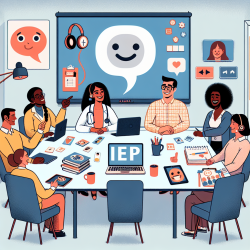As speech therapists, we often encounter moments where we feel lost in our quest to provide the best care for our students. The landscape of speech therapy is continually evolving, and with the advent of technology, we are presented with both challenges and opportunities. Today, I want to discuss how leveraging technology, particularly telepractice, can transform these feelings of being lost into a pathway of inspiration and effective outcomes.
Technology in speech therapy is not a novel concept, but its application has seen significant growth and refinement over recent years. Telepractice, or online speech therapy, has become an invaluable tool, especially in times where in-person sessions are not feasible. Here are several ways in which technology can be harnessed to enhance our practice and ensure that we are delivering the best possible care to our students:
- Accessibility: One of the most profound benefits of telepractice is its ability to reach students who might otherwise have limited access to speech therapy services. This includes students in rural areas, those with transportation challenges, or those who are homebound due to medical conditions.
- Flexibility: Online speech therapy offers a level of flexibility that traditional methods cannot match. It allows for sessions to be scheduled at times that are most convenient for both the therapist and the student, reducing the stress associated with rigid scheduling.
- Engagement: Technology can make sessions more engaging for students. Interactive activities, digital games, and visual aids can be seamlessly integrated into online sessions, making therapy more enjoyable and effective.
- Data-Driven Decisions: Digital platforms often come with built-in data tracking tools. These tools enable therapists to monitor progress, adjust therapy plans in real-time, and make data-driven decisions that are tailored to each student's needs.
- Collaboration: Telepractice facilitates easier collaboration with parents, teachers, and other professionals involved in a student's care. Virtual meetings and shared digital resources ensure that everyone is on the same page and working towards common goals.
At TinyEYE, we are committed to leveraging these technological advancements to create positive outcomes for children. Our online therapy services are designed to be as effective, if not more so, than traditional in-person therapy. We understand that feeling lost can be a part of the journey, but it is also an opportunity to explore new methods and tools that can lead to breakthroughs in our practice.
For those who may feel hesitant about incorporating telepractice into their routine, consider the following steps to ease the transition:
- Start Small: Begin by integrating technology into a few sessions and gradually increase its use as you become more comfortable.
- Seek Training: Take advantage of training programs and resources that can help you become proficient in using online therapy platforms.
- Connect with Peers: Join professional networks or online communities where you can share experiences, ask questions, and gain insights from other therapists who have successfully adopted telepractice.
- Evaluate and Adjust: Continuously evaluate the effectiveness of your online sessions and be willing to make adjustments as needed. Feedback from students and parents can be invaluable in this process.
In conclusion, the integration of technology into speech therapy is not just a trend; it is a transformative approach that can address many of the challenges we face. By embracing telepractice, we can extend our reach, enhance our flexibility, and provide engaging, data-driven therapy that leads to great outcomes for children. At TinyEYE, we believe in the power of technology to inspire and empower both therapists and students. Let us navigate this journey together and turn moments of feeling lost into opportunities for growth and success.










